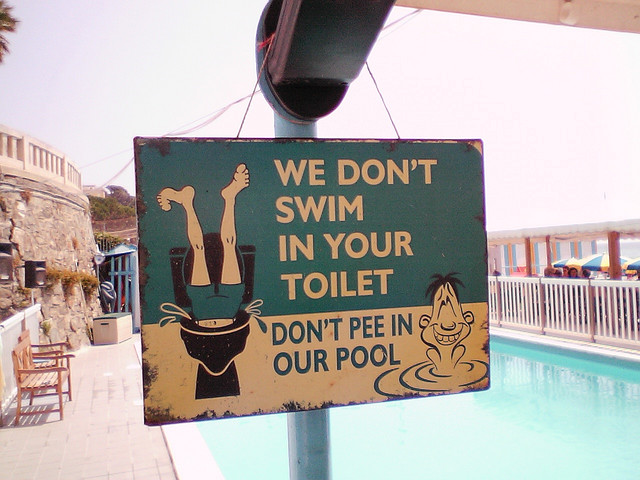Pee. In your pool. You know it happens. You know it’s in there. You know why you don’t want it in there. Urine introduces ammonia, crystallized salts, and other organic compounds. This, along with all of the other bather waste, creates a higher demand for sanitizer and can lead to cloudy water and high combined chlorine (chloramines). Obviously, reducing the amount of urine introduced to your pool is ideal.
Did you know that peeing in the pool is actually a physical response and not just a bad habit from careless swimmers? The effect is called immersion diuresis and is caused by the body’s response to both the temperature of the water and the new found buoyancy. So what can you do to fight the body’s natural response to water?
Breaks. It’s time to give your pool – and therefore, your bathers – a break. A number of local pools, including the YMCA where my daughter attends swim lessons, have instituted a break policy during open swims. Twice an hour for 5 minutes the pool is essentially closed. With the exception of swim lessons (due to their brevity), all bathers must exit the pool for a 5 minute break. This gives parents the chance to direct younger swimmers to the bathroom without undue stress and leaves adult swimmers little else to do but follow suit.
Something as simple as regular, enforced pool breaks can make a huge difference in your water quality. The YMCA mentioned above had been struggling with filtration issues when at capacity (as many YMCA pools always are) and had been experiencing frequent closures because of it. After a particularly lengthy closure, they instituted this break policy. Since then, their water quality has increase, their closures are down, and their filtration and sanitation systems don’t have to work quite so hard to keep up with demand. All of this because they’re keeping a little more pee out of the pool.
For more information on the subject, I highly recommend reading “Peeing in the Pool. Why do we do it and why is it a bad thing?”, an article written by Cliff Pryor that appeared in the NSPF® Prevention Adviser January 2013 newsletter.
Has your pool already introduced pool breaks? What effect has it had on your water quality? We’d love to hear your feedback and additional suggestions on the matter.


